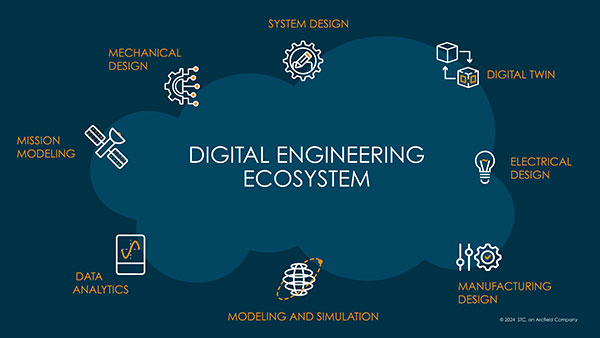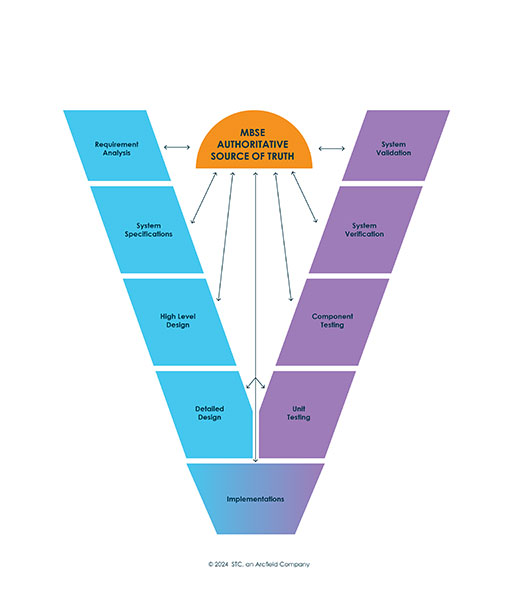The potential of model-based systems engineering to revolutionize automotive design ensures reliability in next-generation vehicles.
By Dan Reineke, President and General Manager of Strategic Technology Consulting, an Arcfield company

The last decade has been transformative for the automotive industry. Automotive systems have evolved from purely mechanical and electrical subsystems to highly complex software platforms. According to research from Goldman Sachs, the average lines of software code per vehicle doubled from 100 million in 2015 to 200 million in 2020.
Features such as adaptive cruise control, anti-collision systems, and Electric Vehicle (EV) battery control systems depend on integrated sensors controlled by robust software systems.
As the automotive industry continues to evolve, these platforms will only become more complex, relying on the communication between onboard and offboard systems to accomplish future autonomous functionality.
So how can automotive original equipment manufacturers (OEMs) combat rising manufacturing costs while keeping up with the increased demand for smarter and more autonomous vehicles? By harnessing the power of model-based systems engineering (MBSE), OEMs can avoid costly errors, optimize resource allocation, and expedite the system development process.

MBSE is an approach to systems engineering that uses a digital model to specify and design complex systems by creating a digital representation of the system’s behavior, structure, and requirements. The digital model can then be used to simulate and test different scenarios before physically building the system. With this method, the risk of system rework post-development is dramatically reduced.
Incorporating MBSE into the design and development process of automotive systems can help manage the inherent complexity of building smart, autonomous vehicles that rely heavily on software systems.
Moreover, MBSE can facilitate multi-domain integration to enable disparate teams working on individual components of the vehicle to effectively collaborate throughout the design and testing process.
Traditionally, this work would entail troves of specifications in the form of documents developed by disparate engineering teams. Now, OEM engineering teams can move quickly, using an authoritative source of truth for the engineering data to facilitate communication between these disparate teams and ensure the systems they advance to production will function as expected. Engineers can also use MBSE to test the vehicle’s performance under countless simulated scenarios, such as extreme temperatures, speeds and weather conditions.
With digital engineering tools, all aspects of the automobile can be digitally modeled and tested, including the structural, thermal and mechanical elements. Integration with the systems engineering models, or specifications of the system, enables teams to perform model-based testing to ensure requirements are being met earlier in the development process. With an accurate digital depiction of the system, countless tests can be performed to simulate the logical properties and behavior of the vehicle under different conditions. As a result, OEMs can save valuable resources and reliably meet the industry’s stringent safety requirements.
In addition to accelerating the design and testing phases, MBSE can be expanded to optimize automotive manufacturer’s feature sets and reduce waste. Model-based product line engineering (MBPLE), also known as feature-based PLE, is an extension of MBSE that involves taking advantage of the commonality shared across a product family while effectively managing variations or differences in specific product models. This eliminates duplication in artifacts and replication of work, resulting in the leanest, most efficient engineering effort possible. In effect, costs and resources will be saved by reusing products and procuring ongoing knowledge of their capabilities to maximize usage.
While the benefits of MBSE and MBPLE are beginning to be widely understood and embraced throughout the automotive sector, it can also be extremely arduous to adequately train existing engineers about how to design and implement MBSE.
Partnering with industry-leading, full-lifecycle MBSE providers can greatly assist OEMs in their quest to reap the many advantages of MBSE for their organization.
The prevalence of autonomous and intelligent vehicles is increasing at an unprecedented rate. As manufacturers strive to keep pace in a dynamic industry, optimize their product lines, and innovate rapidly without compromising on safety protocols, the benefits of MBSE are invaluable and should not be ignored.

Dan Reineke serves as president and general manager of the Strategic Technology Consulting (STC) sector at Arcfield. In this role, Dan leads a highly skilled team of model- based systems engineering (MBSE) and digital engineering (DE) experts that deliver a comprehensive suite of services and solutions, including highly complex modeling methodologies which provide fully integrated systems architecture models to enable next-generation technology development, as well as MBSE-as-a-Service.
Dan joins Arcfield following the company’s acquisition of STC in 2023, a company he founded in 2018. As founder and chief executive officer of STC, Dan worked closely with customers to demonstrate the value of DE, while pushing the boundaries of next-generation systems engineering. With his deep expertise in MBSE and passion for DE, Dan is dedicated to helping organizations streamline their engineering processes and achieve success in their most complex projects.
Prior to the launch of STC, Dan supported multiple defense industry startups and worked with commercial industry customers to automate manual business processes through the adoption of new technologies.
Scott Ellyson, CEO of East West Manufacturing, brings decades of global manufacturing and supply chain leadership to the conversation. In this episode, he shares practical insights on scaling operations, navigating complexity, and building resilient manufacturing networks in an increasingly connected world.